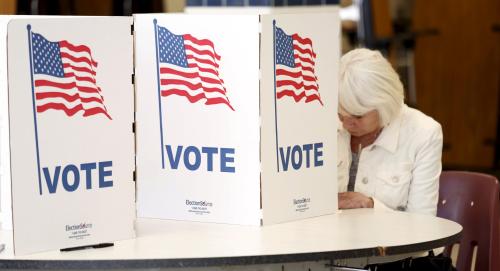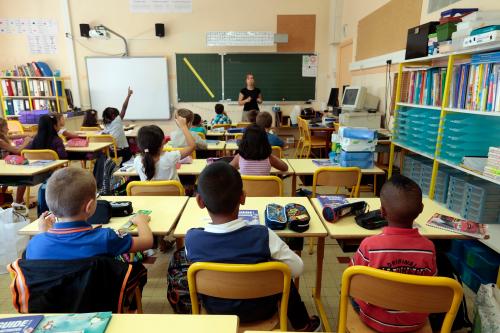Most Americans would agree that public education should serve the educational needs of students. But to what extent does our current governance model—more than 13,000 school-district boards primarily elected by local voters—actually help us realize this goal?
As an illustrative case of how local control can go wrong, consider the East Ramapo Central School District. The school system is located in a racially diverse suburb in New York state. While two-thirds of the district’s residents are white, Black and Latino students account for 92% of district enrollment. Orthodox Jews make up much of the white population and tend to send their kids to private religious schools—which are 98% white and enroll far more students than the public district.
According to recent litigation, white voters effectively control the East Ramapo school board, which has prioritized the interests of white residents and the private schools their kids attend: keeping property taxes low, generously funding special education services for private school students, and selling off public school buildings to private religious schools at below-market rates.
When the district was profiled in an episode of the podcast “This American Life,” the show’s producer asked East Ramapo’s former school board president, “Is there something inherently uncomfortable about a [school] system being governed by folks who don’t use that system or wouldn’t want to use that system?” Although the producer’s focus was specifically on East Ramapo, our research suggests this is a question that we should ask more broadly about America’s public schools.
Are local voters likely to represent the interests of public school students?
We assembled detailed voting records from four states—California, Illinois, Ohio, and Oklahoma—and used them to examine the characteristics of voters who participate in school-board elections. The data enable us to compare the demographics of the electorate that selects each school district’s governing board to the characteristics of students attending local public schools, our proxy for the likelihood that their interests align. Our conclusion is that many American school districts—especially those serving overwhelmingly students of color—share some similarities with East Ramapo.
In each of the four states we examined, we found that voters often look quite different from the local student bodies. Indeed, we found that most of the school districts with majority-nonwhite student bodies are governed by school boards elected by a majority-white electorate—in many cases, an overwhelmingly white electorate. We also find that most school-board voters do not actually have kids, which could exacerbate the implications of this demographic disconnect.
By linking our voter and student records to a national database of student test scores, we found another troubling pattern: The magnitude of the representational gap is associated with racial disparities in student achievement. Specifically, the achievement gap between white and nonwhite students tends to be larger in districts where the electorate looks most dissimilar from the student population. Although we do not argue that these correlations are causal, they suggest that school-board members likely face the least political pressure to close racial achievement gaps in precisely the districts where these gaps are largest. These results may help explain why many school-board members report that they don’t believe voters hold them accountable for taking steps to narrow the gaps.
School governance for the 21st century
As we think about the democratic and policy implications of these patterns—and the possibility of reform—it is worth remembering that our dominant model of school governance is largely a historical accident. The Massachusetts Bay Colony tasked townships with providing public education in the 1600s. When other colonies (and later, states) set up their own school systems, they borrowed heavily from Massachusetts, delegating oversight of public schools to locally elected boards. At various points in American history, however, education reformers recognized that this arrangement sometimes failed to serve the interests of students or society’s broader educational goals. The shift from one-room schoolhouses to larger, grade-based schools in the first half of the 20th century led to substantial district consolidation—from over 200,000 school districts in 1910 to fewer than 20,000 by 1970—and a consequent loss of local control. During this period, school boards also increasingly ceded authority to oversee day-to-day school operations to professionally trained superintendents, and teacher tenure and licensure laws curtailed the allocation of teaching jobs as political patronage. These reforms arguably contributed to the historic gains in educational attainment that were realized in the 20th century.
Today, America’s education system faces significant representational challenges that these earlier waves of governance reform left unaddressed. For example, since 2014, nonwhite students have made up the majority of America’s public school enrollments, with the white share projected to continue shrinking in the coming years. However, the vast majority of school-board members remain white, and American schools have made only modest progress in closing sizeable racial achievement gaps overall. We believe understanding the political pressures facing school boards is essential to designing policy interventions to address these gaps, and our research suggests that current systems of local control may play a role in perpetuating educational and, ultimately, societal inequality.
East Ramapo is perhaps an unusual case of what can happen when the interests of public school students and the voters who govern their districts become almost entirely disconnected. But another recent example demonstrates the risk of ignoring disparities in political participation when designing education reforms. In 2013, California overhauled its state school-funding approach, consolidating a series of categorical programs into a single “local control funding formula” that directs more state money to districts enrolling larger numbers of English Learners and impoverished students. Reflecting then-Gov. Jerry Brown’s belief in the principle of “subsidiarity”—the idea that policy decisions are best made at the lowest level possible—the funds came with few strings attached, and local districts had discretion in allocating these resources to serve high-need students. Although the reform was effective in channeling more state funds to districts serving larger numbers of disadvantaged students, recent analyses showed that only a fraction of these dollars ultimately reached schools enrolling the most disadvantaged students. Instead, a significant share was spent at the district level or divided equally across schools, regardless of how many high-needs students—the state’s intended beneficiaries—they actually enrolled. A state audit concluded that the new policy “has not ensured that funding is benefiting intended student groups and closing achievement gaps,” and other independent evaluations also found inconsistent evidence that the extra money was effective in closing student achievement gaps.
The inequitable outcomes in California should not be surprising. When disadvantaged groups are poorly represented in the political process, elected officials may not have strong incentives to make decisions with their interests in mind.
Potential reforms
What kinds of reforms could strengthen educational governance and improve student outcomes? One possibility might be to increase the influence of higher levels of government. Yet, despite some examples of success involving state takeovers of struggling school districts, the overall track record of these types of interventions seems mixed at best. There are also few good reasons to expect state lawmakers—who are themselves overwhelmingly white—to be more responsive to the needs of minority students than school boards.
Instead, reforms might focus on reforming local electoral laws. For example, there is compelling evidence that holding school-board elections in November of even years, when turnout is highest, produces a more diverse electorate. Moving from at-large to by-district elections can also increase minority representation.
Finally, policymakers may also want to consider opportunities for school choice, especially for disadvantaged families whose public school options are often constrained by housing costs. Policies that allow for greater school choice can empower parents (rather than voters), giving them more direct say over their kids’ education. That is perhaps one reason why surveys report higher rates of satisfaction among parents whose children attend charters school as opposed to traditional public schools.
Regardless of which set of reforms one finds most appealing, it seems clear that a broader conversation about how to ensure that our educational governance model is aligned with the interests of public school students is in order.








Commentary
Who governs our public schools?
February 17, 2021